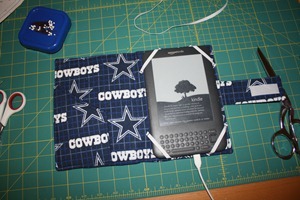I know, it's been way too long! But I've been busy... growing a person :) That's right, we're expecting our third baby in July! First trimester fatigue has hit hard this time around, and so my prime sewing time (after the kids are in bed) has become my prime sleeping time. But I'm getting out of the first trimester now and getting a little more energy, so I'm ready to get back on the sewing wagon!
This past week, I worked on a couple of Christmas gifts for my husband. The first one was a no-sew fleece blanket:
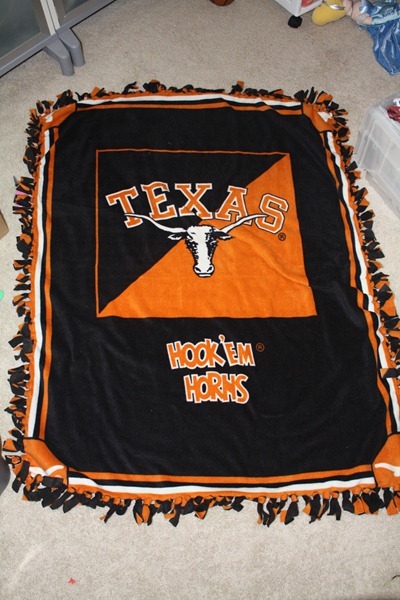
I found the front panel on the red tag shelf at Joann's. The back is plain black fleece. These blankets are technically easy to make (and truly require no sewing), but they're somewhat time-consuming. You cut out a 4" x 4" piece from each corner, and then cut a 4" x 1" fringe all around the blanket. Then you tie a knot on each piece of fringe. That's the part that takes a while. My sewing room now doubles as my office (I guess it really should be the other way around, haha! :) so this was a perfect project to work on while I was stuck on conference calls!
Really, this panel would have worked better as a sewn blanket, if I had left on some of the fleece that originally bordered the design, as a seam allowance. See how the Longhorn logo in each corner gets kinda cut off in the no-sew version? I could have avoided that if I had sewn it. But I didn't realize that until after I had cut off the bordering fleece, and anyway, the Joann's lady cut the solid black fleece just big enough to match the panel, so I didn't really have any extra to work with on the back side. Oh well! It turned out fine anyway.
The second project was a cover for my husband's Kindle:

Since I don't use a Kindle myself, I started off by asking some of my friends who have one what they liked about their covers. There were two big features that most of them liked:
- A pocket on the inside
- A cover that opens like a book and allows for reading without removing the Kindle (as opposed to a pouch/slipcover style)
I did some searching and came up with a bunch of tutorials. I ended up finding inspiration in this tutorial: http://sewlostforyou.blogspot.com/2011/01/kindle-cover-tutorial.html
But it used leather, while I wanted to use Cowboys flannel (left over from making Hubby's pajama shorts for Fathers Day). Leather is a lot thicker/stiffer than flannel, and it doesn't fray, so I had to make quite a few modifications to make my flannel "behave" more like leather.
I started with the closure strap. I used two layers of flannel for this, and put some lightweight interfacing on the wrong side of one layer for stability. Then I sewed the two layers together, turned, and topstitched. Finally, I added a small strip of velcro to the strap. Here's what it looked like when completed:
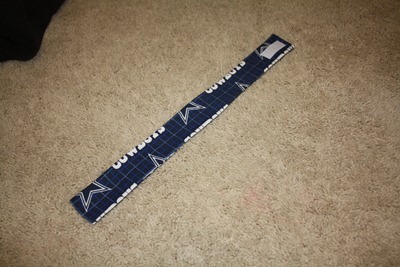
As it turns out, it was way too long -- I'll get to that in a minute.
Then I did the inside pocket. For this one, I folded the flannel and cut an appropriately-sized piece, then added interfacing to the entire piece of flannel. So when I was done, I had two layers of flannel and two layers of interfacing. I cut it on a diagonal -- I totally eyeballed this, but it worked out well. If I were doing it again, I'd make the diagonal hit a little further down on the top edge of the piece of flannel. Anyway, you can see the rough dimensions here, about 7" x 4.5", minus that cutout.
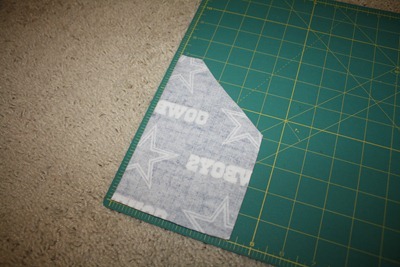
I sewed along the top edge, the diagonal, and the non-folded edge (on the right in the picture above), leaving the bottom open for turning. I turned and topstitched around those three edges, leaving the bottom and the folded side un-topstitched.
Then I cut out the body pieces. I used the same dimensions as given in the tutorial mentioned above, but added half an inch to account for seam allowances, since I would be turning and topstitching. I think each piece ended up being 8.5" x 12". If I were doing it again, I'd add another half inch, and sew with a half inch seam allowance, just to give myself a little more room to work with.
I sewed the other strip of velcro to one body piece. This would become the outside cover.
I pinned the inside pocket to the other body piece, making sure to match up edges. This meant that the (still-open) bottom and the folded edge got sewn up when I sewed the body pieces together:

Finally, I put the two body pieces together, wrong sides facing, and sandwiched the strap between them. In this picture, the outside cover is on top (you can see where the velcro is sewed down, on the left side in the picture below). I helpfully noted that the strap has the velcro tab facing down, towards the inside cover:
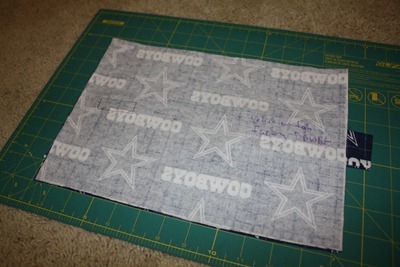
I cut the strap way down! In the original tutorial, the strap goes all the way around the outside of the cover. Mine didn't have to go that far. I think it ended up being about 4.5 inches, with about an inch of that sticking out of the cover piece "sandwich," as you can see above.
Then I stitched the body pieces together, leaving a small opening for turning, at the top. Here's what it looked like after turning... outside:
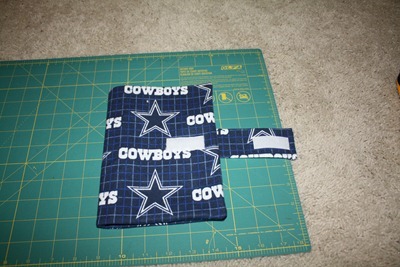
And inside:
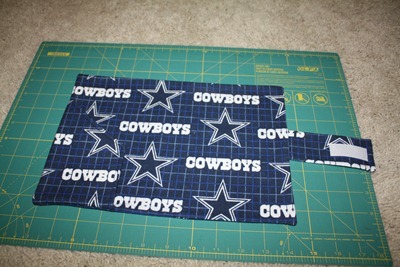
I stuck two pieces of Peltex in through the hole I'd left for turning. (So, that hole should be at least 5" wide or thereabouts. Peltex is SUPER heavy duty interfacing. I had some left over from my failed attempts to make the collar for Littles' Halloween costume, so I was glad to find another use for it. Here's what it looks like inside the cover:

You could also use headliner fabric if you wanted a softer/more padded case. But one thing I discovered in our big move is that I have a lot of fabric, haha. So my mission over the next few months is to sew out of my stash as much as possible!
OK, moving on. This wasn't in the directions for the original tutorial I was following, but I went ahead and fused the Peltex to the fabric, by putting a wet cloth on top of it and ironing.I figured that would keep it from shifting around.
Finally, I topstitched all around the cover body, which also closed up the hole for turning. And I sewed a couple of lines going down the "spine" of the cover.
Here's what it looked like when it was finished!
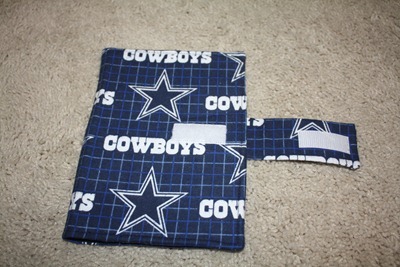
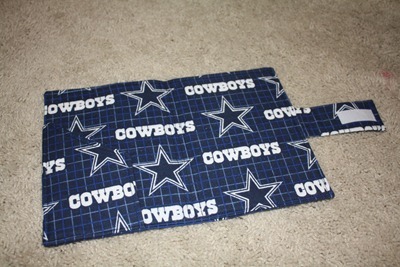
With something in the inside pocket, just to show it off, since it tends to get a little lost in the pattern.
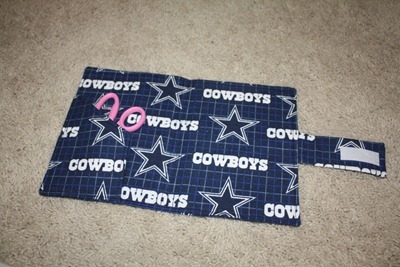
I do have one more thing to completely finish this off. I need to sew four strips of elastic to secure the Kindle in the cover. (Inspired by this tutorial.) I couldn't find Hubby's Kindle when I was working on this, and didn't want to ruin the surprise, so I gave it to him as-is and plan to add those strips now that I can make sure to get them positioned just right.
Now... Hubby got a new Kindle Fire for Christmas! And it fits well inside this cover, too. But he has some suggestions for some minor modifications, e.g. making the strap longer so that he can "stand up" the Kindle Fire when watching movies on it. So, he'll use this one for his original Kindle (which he's keeping) and I'll probably sew another one of these soon. It seems like a lot of steps but it's really not too hard, and should be even easier now that I've figured out the modifications I need to make to that original tutorial.
